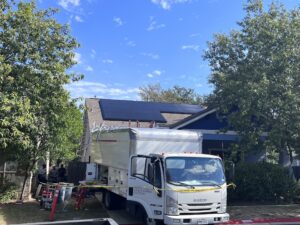With the whopping amount of solar PV adorning rooftops since the 2021 Snowpocalypse, our business members tell us they’ve never been so busy. It’s clear: homeowners are keen on having solar on their roofs and taking advantage of the value that the system adds to their home while they live in it and when they sell it.
Carrie York, Austin real estate broker, is one of those recent solar rooftop homeowners. “After the Snowpocalypse, I decided to go solar,” she said. “I’d wanted to lessen my carbon footprint for some time but losing confidence in our grid was the catalyst.”

Credit: Carrie York
A recent Federal Energy Regulatory Commission (FERC) assessment states that the Texas grid remains almost as vulnerable to extreme winter weather as it was back in February 2021, despite the Texas Public Utility Commission’s assertion that the grid is more reliable than ever.
Although York has been a realtor in Austin for more than three decades, she’s closed only a handful of solar homes. Despite a GREEN designation for REALTORS® which offers a high-performing homes certification, York thinks that few agents really understand the value of rooftop systems, although that might be changing with consumer behavior, much like York.
Mathew Venneman, former mortgage advisor and now with Freedom Solar, concurs with York.
“After speaking with realtors, I found that many of them lacked general knowledge of how solar works or had little to no understanding of what solar can do for their clients and communities. I’m here to change that,” Venneman said. Incidentally, Freedom Solar installed a 100kW rooftop solar system at the Austin Board of Realtor’s headquarters in 2014.
On-line real estate marketplace Zillow gives solar thumbs-up for comfort, livability and utility savings. In 2019, Zillow researchers found that solar homes sold for 4.1% more on average than comparable homes without solar.
“It all depends on how it’s presented to clients,” says Venneman. “Take two homes, one without solar valued at $500K and the other with solar valued at $520K. While the mortgage on the $520K home will be more, perhaps $75-$95/month more, that cost will easily be recovered from the utility savings,” he said. “And that value is exponential…it’s going to increase as utility rates increase. Win-win-win-win.”
Texas law allows property value to go up when homeowners add wind or solar systems but doesn’t increase property taxes. “Property value added from PV systems is 100% tax-exempt,” says Venneman.
Valuing a rooftop system depends on whether the panels are leased, financed or bought outright.
According to Fannie Mae, solar panels can only be included in the home’s appraised value if they’re owned outright or financed as a home fixture so that they can’t be repossessed if the loan defaults. Being able to include panels in an appraisal and sell them as part of the property simplifies the lending process for potential buyers. Owners of solar systems are also eligible for the 30% federal tax credit.
But not everyone can afford the upfront cost of the system which can run into the tens of thousands depending on size and storage capabilities.
Systems can be financed. In fact, the 30% federal tax credit extends to financed panels as well. Typically, most mortgage lenders require the system to be paid off and transferred to the new owner upon closing to prevent the property from being devalued should the panels be repossessed by a third-party lender.
“I went with company financing and got the 30% federal tax credit,” said York. “In my opinion, lenders aren’t up to speed in this area, and they tend to go with what the appraiser says. Clearly it’s a process that needs work so the home and system realize the proper value. Now that I’m a solar homeowner, I’ll be educating buyers and lenders about the process.”
Finally, homeowners can have a solar lease or PPA (power purchase agreement) and while the easiest way to go solar, it’s the most complicated option for the seller.
In a solar lease or PPA, the homeowner buys power from a solar company, rather than buying the solar system itself. In this case, lenders take the position that because the panels are owned by a third party, appraisers are unlikely to attribute value to them.
With a standard lease, a solar provider charges fixed monthly payments (or sometimes escalating payments over the life of the lease), regardless of the amount of power you receive from the panels. By contrast, a power purchase agreement bills you a fixed rate per kWh of power produced by the panels.
Some companies will guarantee a certain amount of energy production from your panels and will refund you the difference if the system produces less. The leasing company is also responsible for the maintenance of the panels.
“I always tell homeowners that if it sounds too good to be true, then most likely it is too good to be true,” said Venneman. “If a solar company is offering 20-year leasing terms and has been in business for less than five years, it’s probably best to go a different route.”
With his mortgage background, Venneman offers a free solar 101 training for realtors and mortgage bankers. “No other asset…not a pool, kitchen or bathroom upgrade will give your home the kind of monthly dividend that a solar roof will give you,” said Venneman. “We’re changing the way Texans get their power!”
Resources:
PV Value Photovoltaic Energy Valuation Model: Online tool to calculate the lifetime value of PV panels
Pearl National Home Certification: Third party certification for high-performing homes
National Association of REALTORS GREEN designation
Appraising Properties with Solar Panels, Fannie Mae 2020 [PDF]
